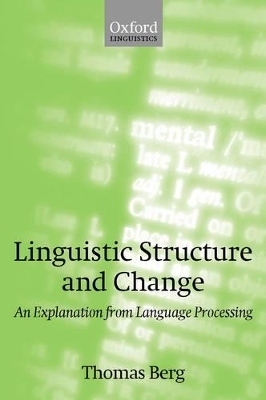
Linguistic Structure and Change
An Explanation from Language Processing
Seiten
2001
Oxford University Press (Verlag)
978-0-19-829985-1 (ISBN)
Oxford University Press (Verlag)
978-0-19-829985-1 (ISBN)
This text is concerned with the way the term "explanation" is typically used in linguistics. It argues that real explanations cannot emerge from a view which asserts the autonomy of language, but only from an approach which seeks to establish a connection between language and its contexts.
Thomas Berg challenges context-free theories of linguistics; he is concerned with how the term 'explanation' is typically used in the discipline. He argues that real explanations cannot emerge from a view which asserts the autonomy of language, but only from an approach which seeks to establish a connection between language and the contexts in which it is embedded.
The author examines the psychological context in detail. He uses an interactive activation model of language processing to derive predictions about synchronic linguistic patterns, the course of linguistic change, and the structure of poetic rhymes. The majority of these predictions are borne out, and the author concludes that the structure of language is shaped by the properties of the mechanism which puts it to use, and that psycholinguistics thus qualifies as one likely approach from which to derive an explanation of linguistic structure.
Thomas Berg challenges context-free theories of linguistics; he is concerned with how the term 'explanation' is typically used in the discipline. He argues that real explanations cannot emerge from a view which asserts the autonomy of language, but only from an approach which seeks to establish a connection between language and the contexts in which it is embedded.
The author examines the psychological context in detail. He uses an interactive activation model of language processing to derive predictions about synchronic linguistic patterns, the course of linguistic change, and the structure of poetic rhymes. The majority of these predictions are borne out, and the author concludes that the structure of language is shaped by the properties of the mechanism which puts it to use, and that psycholinguistics thus qualifies as one likely approach from which to derive an explanation of linguistic structure.
Thomas Berg is Professor of Linguistics at the University of Hamburg.
1. On the 'Art' of Explanation ; 2. Explanation from a Macrolinguistic Perspective ; 3. Method ; 4. Language Structure ; 5. Language Change ; 6. Poetic Language ; 7. Discussion ; 8. A Psycholinguistic Model of Language Structure and Change ; 9. Implications for Psycholinguistic Theory ; 10. The Overall Perspective: Reductionist or Non-Reductionist?
| Erscheint lt. Verlag | 1.3.2001 |
|---|---|
| Zusatzinfo | 4 black and white line figures |
| Verlagsort | Oxford |
| Sprache | englisch |
| Maße | 156 x 233 mm |
| Gewicht | 507 g |
| Themenwelt | Geisteswissenschaften ► Philosophie ► Sprachphilosophie |
| Geisteswissenschaften ► Sprach- / Literaturwissenschaft ► Sprachwissenschaft | |
| ISBN-10 | 0-19-829985-0 / 0198299850 |
| ISBN-13 | 978-0-19-829985-1 / 9780198299851 |
| Zustand | Neuware |
| Haben Sie eine Frage zum Produkt? |
Mehr entdecken
aus dem Bereich
aus dem Bereich
Macht und Legitimität politischer Sprache im Prozess der europäischen …
Buch | Softcover (2023)
Nomos (Verlag)
CHF 103,60
KI, Kreativität und algorithmische Postrationalität
Buch | Softcover (2024)
Matthes & Seitz Berlin (Verlag)
CHF 23,90
Wie die Menschheit zu ihrer größten Erfindung kam
Buch | Softcover (2022)
C.H.Beck (Verlag)
CHF 25,20


